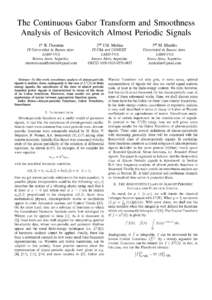Por favor, use este identificador para citar o enlazar este ítem:
https://repositorio.uca.edu.ar/handle/123456789/17556| Título: | The continuous Gabor transform and smoothness : analysis of Besicovitch almost periodic signals | Autor: | Florentin, R. Medina, Juan Miguel Miralles, Mónica Teresita |
Palabras clave: | MECANICA DE FLUIDOS; DESVIACION DE ESFERICIDAD; FUNCIONES CASI PERIODICAS; ESPECTROMETRIA; OSCILACIONES | Fecha de publicación: | 2023 | Cita: | Florentin, R., Medina, J. M., Miralles, M. T. The continuous Gabor transform and smoothness : analysis of Besicovitch almost periodic signals En: Reunión de Trabajo en Procesamiento de la Información y Control : 1 al 3 de noviembre. Oberá : Universidad Nacional de Misiones. Facultad de Ingeniería, 2023. Disponible en: https://repositorio.uca.edu.ar/handle/123456789/17556 | Proyecto: | Adquisición y procesamiento de señales biológicas asociadas a la biomecánica del adulto mayor y al riesgo de caída | Resumen: | Abstract: Almost-periodic functions are a useful model of persistent signals. In real life, the occurrence of almost-periodic oscillations is much more common than exact periodic ones. Almostperiodic functions were extensively studied by H. Bohr, V. Stepanov, N. Wiener, A.S. Besicovitch [3], [17] among other renown scientists. Initially, this theory was concerned with the study of the almost-periodicity of the solutions of differential equations. As shown in [7], for example, if we consider the wave equation ux x = k2ut t , with the non-ideal boundary condition: u(t, 0) = 0, ux(t, l) + hu(t, l) = 0, h > 0, then we get almost-periodic solutions to the wave equation. A possible physic interpretation could be the following: u(x, t) describes the motion of a vibrating elastic string such that it is fixed at x = 0 and whose end at x = l has its tension ux(t, l) proportional to the elongation u(t, l). Apart from mathematical physics, almost-periodic waves or oscillations appear in other dynamical systems and Control Theory [13]. On the other hand, they are a subclass of functions to which the Generalized Harmonic Analysis tools, first developed by Wiener, can be applied to them [1]. As it is discussed in [2], these tools are also well adapted for interpreting spectral bio-electric data, where non-periodic and persistent rhythms appear and the usual finite-energy techniques (i.e. L2(R)) of harmonic analysis cannot be applied. Finally, there has been a substantial research in how some usual time-frequency representations, i.e. Wavelets and Gabor transforms, can be adapted to this scenery. Some positive answers about the representation of almost-periodic signals were given in e.g. [4], [11], [12], [14] and more recently in [5]. Gabor and Wavelet Transform not only give, in some sense, optimal representations of signals but also are useful signal analysis tools, at least in the finite-energy context. We note, however, that this fact it is not discussed, for the almost-periodic case, in none of these referenced works. Here, we shall discuss some of these facts for the Gabor (or Short Time Fourier Transform). In the finite-energy context, smoothness or regularity analysis is very well described in terms of decay of Gabor or Wavelet coefficients or as equivalences of norms. Smoothness analysis is of certain importance in the classification of signals. In contrast to the L2(R) setup, here we will prove some analogue results for the Gabor Transform of almost-periodic signals. There exist several definitions of almost-periodicity with increasing generality. Here will be concerned with the Besicovitch class of almost-periodic signals. In particular, these functions constitute a closed subspace of almost-periodic signals included in the more general (Hilbert) vector space of Bounded Quadratic Mean functions, i.e. Bounded Power signals. The paper is organized as follows: first the Besicovitch class of Almost Periodic signals is introduced. In Section II-A time frequency-analysis of almost periodic functions is discussed. Finally, the main results on smoothness analysis are given in Section III. A brief practical and preliminar example on biomedical time series is presented there. | URI: | https://repositorio.uca.edu.ar/handle/123456789/17556 | Disciplina: | INGENIERIA | DOI: | 10.1109/RPIC59053.2023.10530753 | Derechos: | Acceso restringido | Fuente: | Reunión de Trabajo en Procesamiento de la Información y Control : 1 al 3 de noviembre. Oberá : Universidad Nacional de Misiones. Facultad de Ingeniería, 2023 |
| Aparece en las colecciones: | Ponencias |
Ficheros en este ítem:
| Fichero | Descripción | Tamaño | Formato | Login |
|---|---|---|---|---|
| continuous-gabor.pdf | 448,43 kB | Adobe PDF | SOLICITAR ACCESO | |
| thumb.jpg | 495,55 kB | JPEG |  Visualizar/Abrir |
Visualizaciones de página(s)
55
comprobado en 27-abr-2024
Descarga(s)
18
comprobado en 27-abr-2024
Google ScholarTM
Ver en Google Scholar
Altmetric
Altmetric
Este ítem está sujeto a una Licencia Creative Commons

